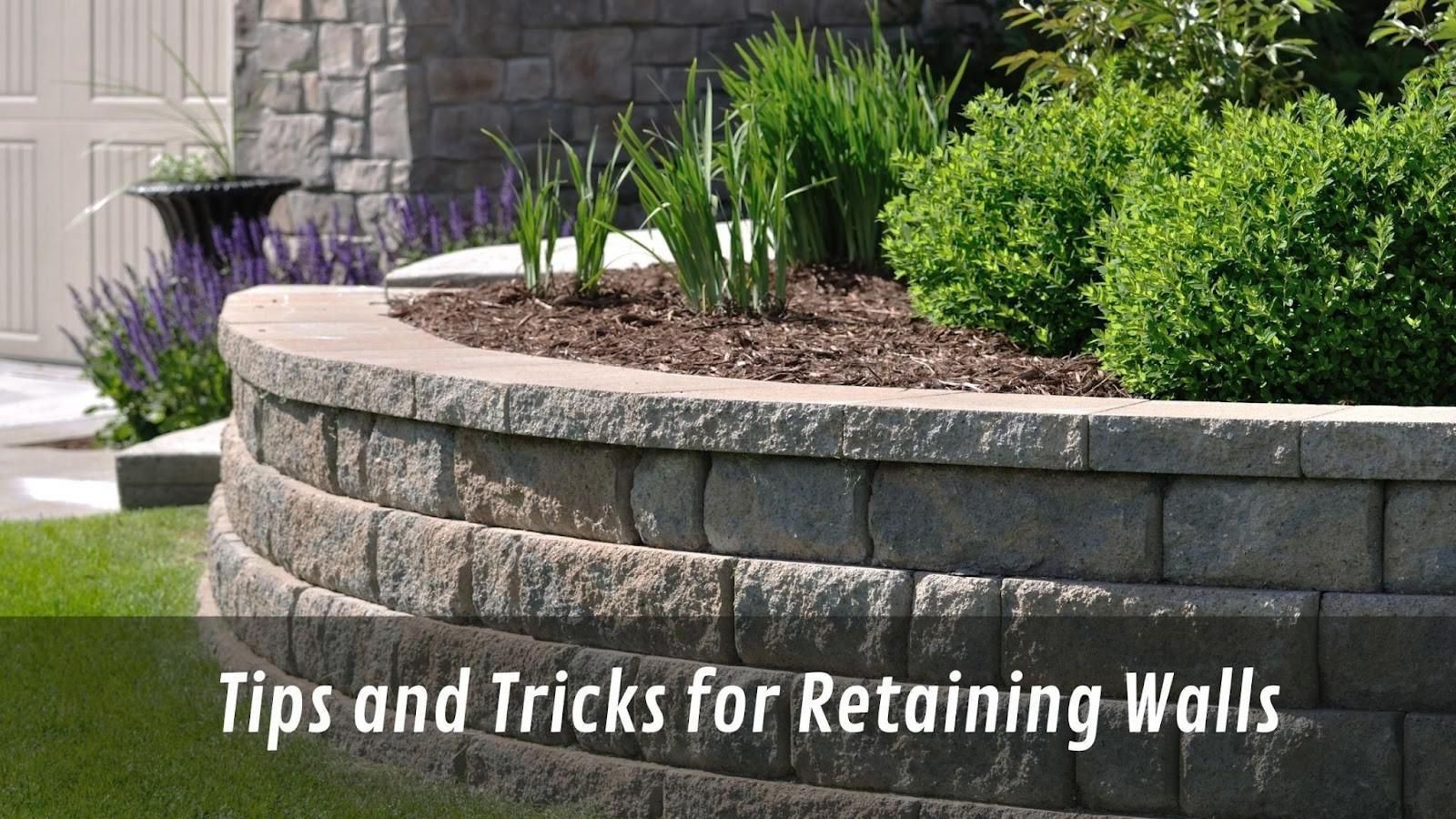We'll go over different types of retaining walls, how to build them, and some design ideas to get you started. So whether you're looking to add retaining walls to your property or just want to learn more about them, this is the page for you!
Types of Retaining Walls:
There are many different types of retaining walls out there, but they can broadly be classified into two categories: timber and concrete. Timber retaining walls are usually made from wood or logs, while concrete ones are made from... you guessed it, concrete! Each type has its own advantages and disadvantages, so it's important to choose the right one for your project.
How to Build a Retaining Wall: Building a retaining wall is a big project, but it's definitely doable if you're prepared and have the right supplies. First, you'll need to choose the type of timber retaining wall you want to build. Once you've done that, determine how high and long you need your wall to be. Next, dig a trench for the foundation of your wall and tamp down the soil. Then, lay down your foundation (whether it's concrete or timber) and start building up your wall. Be sure to compact the soil as you go to prevent any settles or erosion. Finally, finish off your wall with a top course (again, either concrete or timber) and you're done!
Design Ideas for Retaining Walls: The sky's the limit when it comes to designing your retaining wall. You can go for a classic look with straight lines and clean angles, or get more creative with curves and different textures. If you're using concrete blocks, you can even stain them or paint them to add a pop of color. And of course, don't forget about plantings! Adding some greenery to your retaining wall will not only make it look more attractive but can also help to stabilize the soil. So whether you're going for function or fashion (or both!), there are endless possibilities for designing your retaining wall.
That's all for now! We hope you found this page helpful and that you're feeling inspired to get started on your own retaining wall project. Thanks for reading!
Where we can get retaining wall ideas?
There are a few places you can get retaining wall ideas. Paving is one option. You can also look into timber retaining walls or concrete retaining walls. Another option is to simply use paving stones to create a design that will accent your home while also providing support for any landscaping needs you may have. No matter what route you decide to go, be sure to consider the following tips and tricks to get the most out of your new retaining wall.
1. Paving patterns can add both visual interest and stability to your wall. Basketweave, herringbone, and running bond are all popular choices that can be easily incorporated into your design.
2. If you're using a concrete retaining wall, make sure to treat it with a water-resistant sealant. This will help protect it from the elements and extend its lifespan.
3. For extra stability, you can add geogrid fabric to your retaining wall. This material is used to reinforce soil and is available at most home improvement stores.
4. If you're using concrete blocks for your retaining wall, be sure to use ones that are specifically designed for this purpose. Regular cinder blocks are not typically strong enough to withstand the weight of dirt and rocks.
5. To give your retaining wall a more natural look, consider using stone veneer instead of solid concrete or block. Stone veneer is thinner and lighter than traditional masonry, making it easy to work with and install.
6. If you're looking for a more permanent solution, consider pouring concrete instead of using blocks or timbers. Poured concrete walls can last for decades with proper care and maintenance.
7. For the most stability, make sure your retaining wall is at least two feet wide. This will give it enough surface area to effectively hold back soil and prevent it from collapsing.
8. To ensure good drainage, make sure there are weep holes drilled into the bottom course of your retaining wall. These holes allow water to escape, preventing moisture from building up and causing the wall to fail.
9. Finally, be sure to backfill your retaining wall with gravel before adding soil. This will help improve drainage and prevent any settling that could occur over time.
By following these tips, you can be sure that your retaining wall will be built to last. Paving is a great way to add both function and style to your home, so don't hesitate to give it a try!



 women in street dancing
Photo by
women in street dancing
Photo by  man and woman standing in front of louver door
Photo by
man and woman standing in front of louver door
Photo by  man in black t-shirt holding coca cola bottle
Photo by
man in black t-shirt holding coca cola bottle
Photo by  red and white coca cola signage
Photo by
red and white coca cola signage
Photo by  man holding luggage photo
Photo by
man holding luggage photo
Photo by  topless boy in blue denim jeans riding red bicycle during daytime
Photo by
topless boy in blue denim jeans riding red bicycle during daytime
Photo by  trust spelled with wooden letter blocks on a table
Photo by
trust spelled with wooden letter blocks on a table
Photo by  Everyone is Welcome signage
Photo by
Everyone is Welcome signage
Photo by  man with cap and background with red and pink wall l
Photo by
man with cap and background with red and pink wall l
Photo by  difficult roads lead to beautiful destinations desk decor
Photo by
difficult roads lead to beautiful destinations desk decor
Photo by  photography of woman pointing her finger near an man
Photo by
photography of woman pointing her finger near an man
Photo by  closeup photography of woman smiling
Photo by
closeup photography of woman smiling
Photo by  a man doing a trick on a skateboard
Photo by
a man doing a trick on a skateboard
Photo by  two men
two men  running man on bridge
Photo by
running man on bridge
Photo by  orange white and black bag
Photo by
orange white and black bag
Photo by  girl sitting on gray rocks
Photo by
girl sitting on gray rocks
Photo by  assorted-color painted wall with painting materials
Photo by
assorted-color painted wall with painting materials
Photo by  three women sitting on brown wooden bench
Photo by
three women sitting on brown wooden bench
Photo by 
 Photo by
Photo by  Photo by
Photo by  Photo by
Photo by  Photo by
Photo by 


 people sitting on chair in front of computer
people sitting on chair in front of computer



 all stars lol GIF by Lifetime
all stars lol GIF by Lifetime two women talking while looking at laptop computerPhoto by
two women talking while looking at laptop computerPhoto by  shallow focus photography of two boys doing wacky facesPhoto by
shallow focus photography of two boys doing wacky facesPhoto by  happy birthday balloons with happy birthday textPhoto by
happy birthday balloons with happy birthday textPhoto by  itty-bitty living space." | The Genie shows Aladdin how… | Flickr
itty-bitty living space." | The Genie shows Aladdin how… | Flickr shallow focus photography of dog and catPhoto by
shallow focus photography of dog and catPhoto by  yellow Volkswagen van on roadPhoto by
yellow Volkswagen van on roadPhoto by  orange i have a crush on you neon light signagePhoto by
orange i have a crush on you neon light signagePhoto by  5 Tattoos Artist That Will Make You Want A Tattoo
5 Tattoos Artist That Will Make You Want A Tattoo woman biting pencil while sitting on chair in front of computer during daytimePhoto by
woman biting pencil while sitting on chair in front of computer during daytimePhoto by  a scrabbled wooden block spelling the word prizePhoto by
a scrabbled wooden block spelling the word prizePhoto by 
 StableDiffusion
StableDiffusion
 StableDiffusion
StableDiffusion
 StableDiffusion
StableDiffusion





